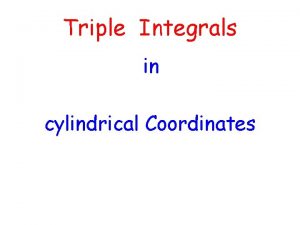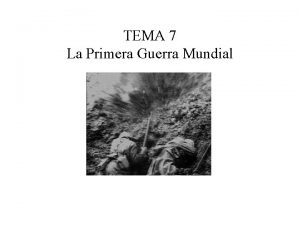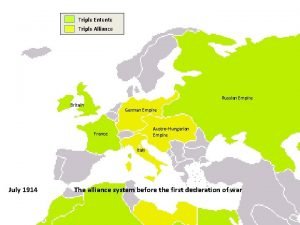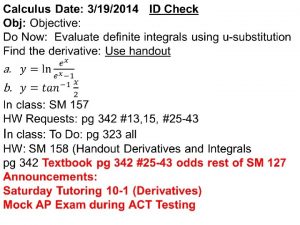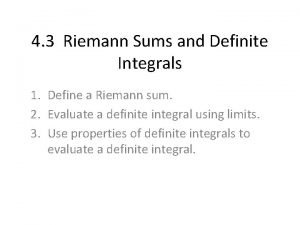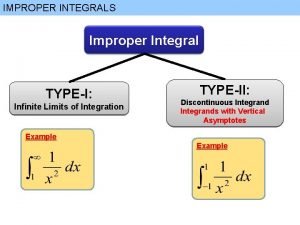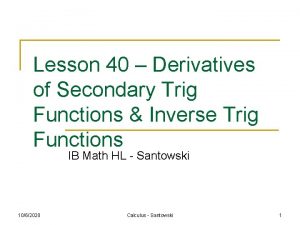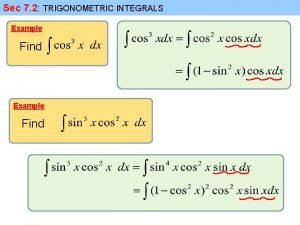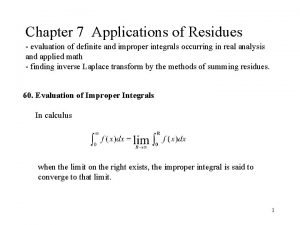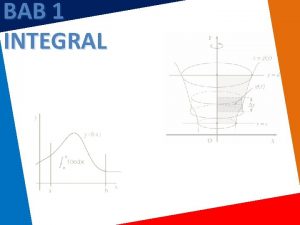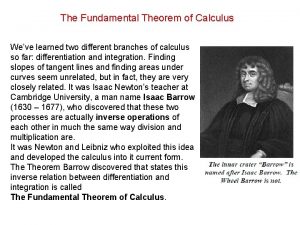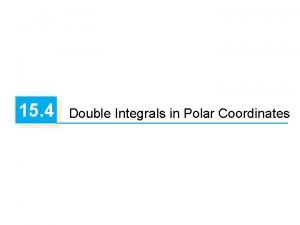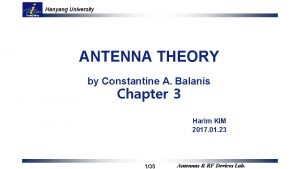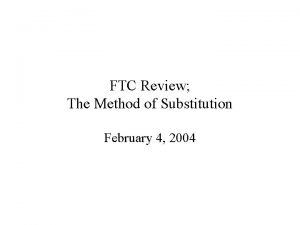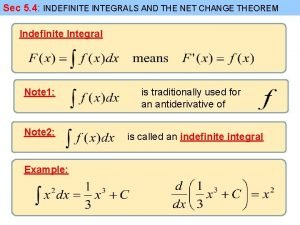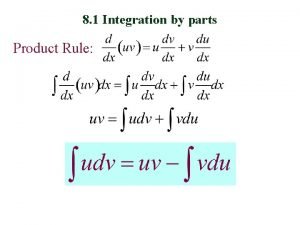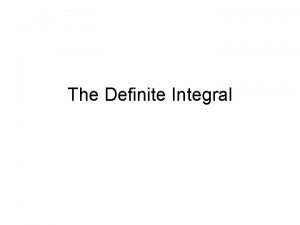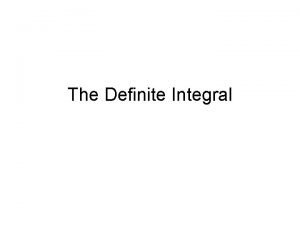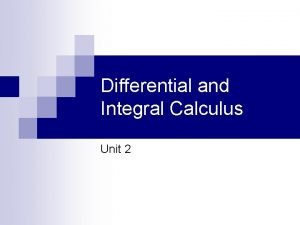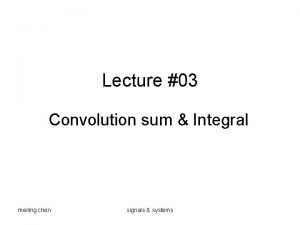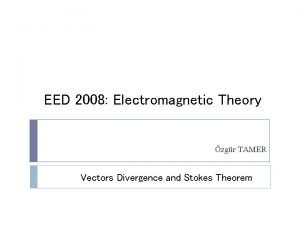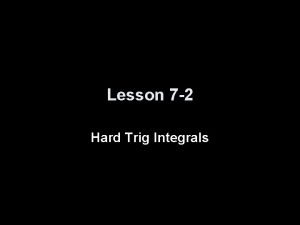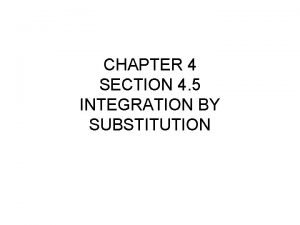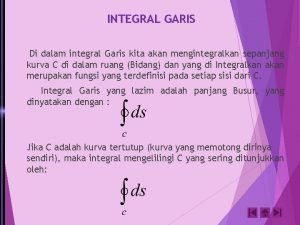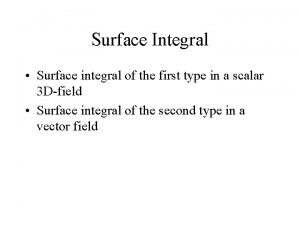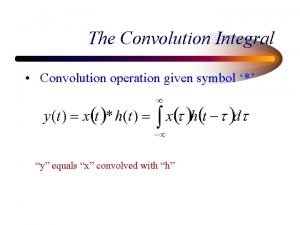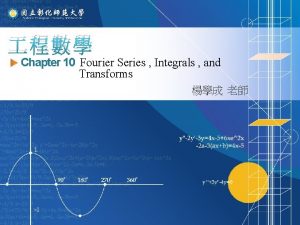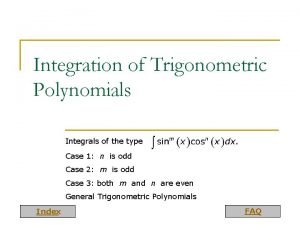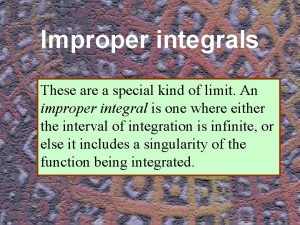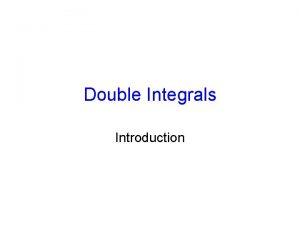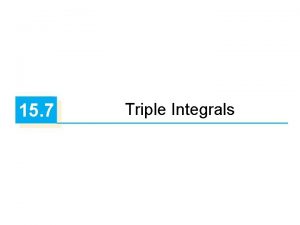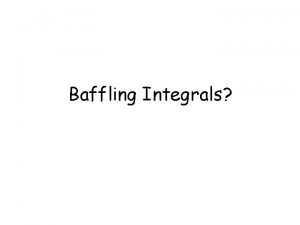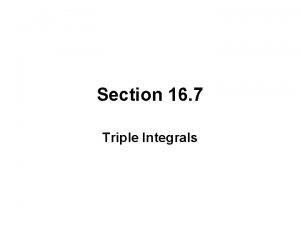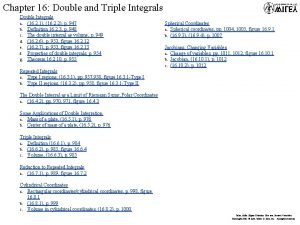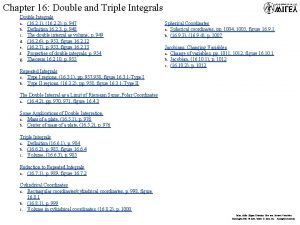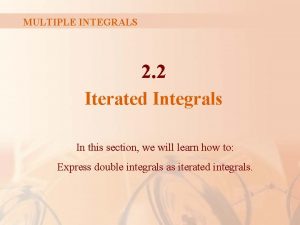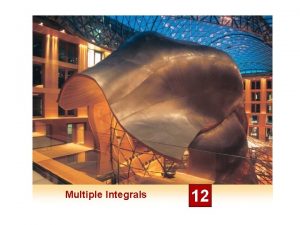15 MULTIPLE INTEGRALS MULTIPLE INTEGRALS 15 8 Triple














































- Slides: 46

15 MULTIPLE INTEGRALS

MULTIPLE INTEGRALS 15. 8 Triple Integrals in Spherical Coordinates In this section, we will learn how to: Convert rectangular coordinates to spherical ones and use this to evaluate triple integrals.

SPHERICAL COORDINATE SYSTEM Another useful coordinate system in three dimensions is the spherical coordinate system. § It simplifies the evaluation of triple integrals over regions bounded by spheres or cones.

SPHERICAL COORDINATES The spherical coordinates (ρ, θ, Φ) of a point P in space are shown. § ρ = |OP| is the distance from the origin to P. § θ is the same angle as in cylindrical coordinates. § Φ is the angle between the positive z-axis and the line segment OP.

SPHERICAL COORDINATES Note that: §ρ≥ 0 § 0≤θ≤π

SPHERICAL COORDINATE SYSTEM The spherical coordinate system is especially useful in problems where there is symmetry about a point, and the origin is placed at this point.

SPHERE For example, the sphere with center the origin and radius c has the simple equation ρ = c. § This is the reason for the name “spherical” coordinates.

HALF-PLANE The graph of the equation θ = c is a vertical half-plane.

HALF-CONE The equation Φ = c represents a half-cone with the z-axis as its axis.

SPHERICAL & RECTANGULAR COORDINATES The relationship between rectangular and spherical coordinates can be seen from this figure.

SPHERICAL & RECTANGULAR COORDINATES From triangles OPQ and OPP’, we have: z = ρ cos Φ r = ρ sin Φ § However, x = r cos θ y = r sin θ

SPH. & RECT. COORDINATES Equations 1 So, to convert from spherical to rectangular coordinates, we use the equations x = ρ sin Φ cos θ y = ρ sin Φ sin θ z = ρ cos Φ

SPH. & RECT. COORDINATES Equation 2 Also, the distance formula shows that: ρ2 = x 2 + y 2 + z 2 § We use this equation in converting from rectangular to spherical coordinates.

SPH. & RECT. COORDINATES Example 1 The point (2, π/4, π/3) is given in spherical coordinates. Plot the point and find its rectangular coordinates.

SPH. & RECT. COORDINATES Example 1 We plot the point as shown.

SPH. & RECT. COORDINATES From Equations 1, we have: Example 1

SPH. & RECT. COORDINATES Example 1 Thus, the point (2, π/4, π/3) is in rectangular coordinates.

SPH. & RECT. COORDINATES The point Example 2 is given in rectangular coordinates. Find spherical coordinates for the point.

SPH. & RECT. COORDINATES From Equation 2, we have: Example 2

SPH. & RECT. COORDINATES So, Equations 1 give: § Note that θ ≠ 3π/2 because Example 2

SPH. & RECT. COORDINATES Example 2 Therefore, spherical coordinates of the given point are: (4, π/2 , 2π/3)

EVALUATING TRIPLE INTEGRALS WITH SPH. COORDS. In the spherical coordinate system, the counterpart of a rectangular box is a spherical wedge where: a ≥ 0, β – α ≤ 2π, d – c ≤ π

EVALUATING TRIPLE INTEGRALS Although we defined triple integrals by dividing solids into small boxes, it can be shown that dividing a solid into small spherical wedges always gives the same result.

EVALUATING TRIPLE INTEGRALS Thus, we divide E into smaller spherical wedges Eijk by means of equally spaced spheres ρ = ρi, half-planes θ = θj, and halfcones Φ = Φk.

EVALUATING TRIPLE INTEGRALS The figure shows that Eijk is approximately a rectangular box with dimensions: § Δρ, ρi ΔΦ (arc of a circle with radius ρi, angle ΔΦ) § ρi sinΦk Δθ (arc of a circle with radius ρi sin Φk, angle Δθ)

EVALUATING TRIPLE INTEGRALS So, an approximation to the volume of Eijk is given by:

EVALUATING TRIPLE INTEGRALS In fact, it can be shown, with the aid of the Mean Value Theorem, that the volume of Eijk is given exactly by: where is some point in Eijk.

EVALUATING TRIPLE INTEGRALS Let be the rectangular coordinates of that point.

EVALUATING TRIPLE INTEGRALS Then,

EVALUATING TRIPLE INTEGRALS However, that sum is a Riemann sum for the function § So, we have arrived at the following formula for triple integration in spherical coordinates.

TRIPLE INTGN. IN SPH. COORDS. Formula 3 where E is a spherical wedge given by:

TRIPLE INTGN. IN SPH. COORDS. Formula 3 says that we convert a triple integral from rectangular coordinates to spherical coordinates by writing: x = ρ sin Φ cos θ y = ρ sin Φ sin θ z = ρ cos Φ

TRIPLE INTGN. IN SPH. COORDS. That is done by: § Using the appropriate limits of integration. § Replacing d. V by ρ2 sin Φ dρ dθ dΦ.

TRIPLE INTGN. IN SPH. COORDS. The formula can be extended to include more general spherical regions such as: § The formula is the same as in Formula 3 except that the limits of integration for ρ are g 1(θ, Φ) and g 2(θ, Φ).

TRIPLE INTGN. IN SPH. COORDS. Usually, spherical coordinates are used in triple integrals when surfaces such as cones and spheres form the boundary of the region of integration.

TRIPLE INTGN. IN SPH. COORDS. Evaluate where B is the unit ball: Example 3

TRIPLE INTGN. IN SPH. COORDS. Example 3 As the boundary of B is a sphere, we use spherical coordinates: § In addition, spherical coordinates are appropriate because: x 2 + y 2 + z 2 = ρ2

TRIPLE INTGN. IN SPH. COORDS. So, Formula 3 gives: Example 3

TRIPLE INTGN. IN SPH. COORDS. Note It would have been extremely awkward to evaluate the integral in Example 3 without spherical coordinates. § In rectangular coordinates, the iterated integral would have been:

TRIPLE INTGN. IN SPH. COORDS. Example 4 Use spherical coordinates to find the volume of the solid that lies: § Above the cone § Below the sphere x 2 + y 2 + z 2 = z

TRIPLE INTGN. IN SPH. COORDS. Example 4 Notice that the sphere passes through the origin and has center (0, 0, ½). § We write its equation in spherical coordinates as: ρ2 = ρ cos Φ or ρ = cos Φ

TRIPLE INTGN. IN SPH. COORDS. Example 4 The equation of the cone can be written as: § This gives: sinΦ = cosΦ or Φ = π/4

TRIPLE INTGN. IN SPH. COORDS. Example 4 Thus, the description of the solid E in spherical coordinates is:

TRIPLE INTGN. IN SPH. COORDS. Example 4 The figure shows how E is swept out if we integrate first with respect to ρ, then Φ, and then θ.

TRIPLE INTGN. IN SPH. COORDS. The volume of E is: Example 4

TRIPLE INTGN. IN SPH. COORDS. This figure gives another look (this time drawn by Maple) at the solid of Example 4.
 Triple integrals
Triple integrals Triple alliance vs allied powers
Triple alliance vs allied powers Site:slidetodoc.com
Site:slidetodoc.com Triple alianza y triple entente
Triple alianza y triple entente Triple entente ww1
Triple entente ww1 三国同盟
三国同盟 Change of variables multiple integrals
Change of variables multiple integrals Triple des advantages and disadvantages
Triple des advantages and disadvantages Substitution rule
Substitution rule Definite integrals as a limit of a sum
Definite integrals as a limit of a sum Application of residue theorem to evaluate real integrals
Application of residue theorem to evaluate real integrals Improper integrals
Improper integrals Trig functions
Trig functions Sec 7
Sec 7 Fubini's theorem
Fubini's theorem Application of residue theorem to evaluate real integrals
Application of residue theorem to evaluate real integrals Integration by substitution
Integration by substitution Exploration 1-3a introduction to definite integrals
Exploration 1-3a introduction to definite integrals Konsep integral
Konsep integral Second fundamental theorem of calculus
Second fundamental theorem of calculus Double integrals in polar coordinates
Double integrals in polar coordinates Duality theorem in antenna
Duality theorem in antenna Circuit training properties of definite integrals
Circuit training properties of definite integrals Integrals involving powers of secant and tangent
Integrals involving powers of secant and tangent Definite integral and indefinite integral
Definite integral and indefinite integral Product rule integrals
Product rule integrals Calculus chapter 5
Calculus chapter 5 Contoh soal integral permukaan
Contoh soal integral permukaan Rule of integration
Rule of integration Product rule
Product rule Definite integral sigma notation
Definite integral sigma notation Definite integral denotes
Definite integral denotes Rate of change examples
Rate of change examples Signals and systems
Signals and systems Area enclosed by curve and x axis
Area enclosed by curve and x axis Curl formula in spherical coordinates
Curl formula in spherical coordinates Hard trig integrals
Hard trig integrals Properties of indefinite integrals
Properties of indefinite integrals Integration by substitution
Integration by substitution Integral garis dengan kurva tertutup
Integral garis dengan kurva tertutup Surface integrals
Surface integrals Convolution integral example
Convolution integral example Fourier series and integrals
Fourier series and integrals Maurits w. haverkort
Maurits w. haverkort Trig integral identities
Trig integral identities Improper integrals
Improper integrals Double integral volume
Double integral volume
